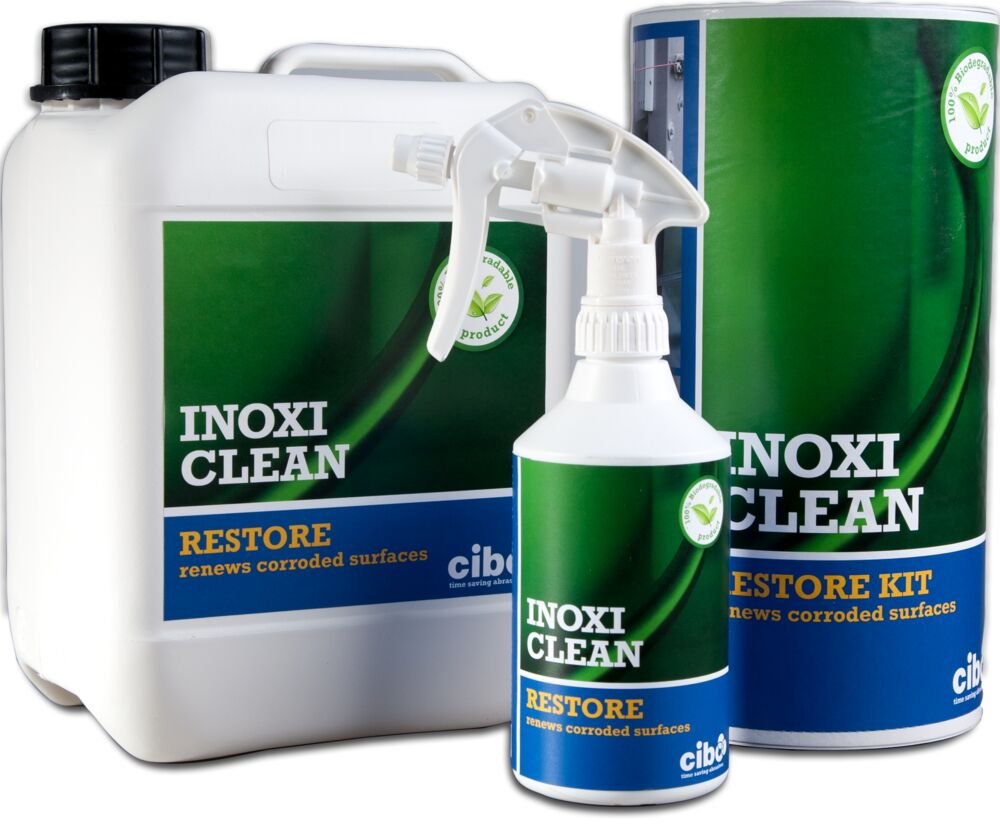21/02/2024
Stainless steel can rust! But Cibo can solve it.
Acid rain, steel particles, sea air and other environmental factors corrode the surface of stainless steel. They lead to corrosion and make the surface dull and dirty. Stainless steel is a type of alloy steel that includes iron, nickel, chromium and molybdenum. The amount of nickel determines whether or not stainless steel is magnetic or only slightly magnetic. The molybdenum makes stainless steel more resistant to chlorides.
The amount of chromium in the alloy is very important and determines the corrosion-resistant properties of the material. To speak of stainless steel, at least 10.5% chromium is needed. Chromium in contact with oxygen from the air forms a wafer-thin chromium oxide skin on the surface. This protects the underlying steel from corrosion and thus makes the steel stainless.
And yet. Stainless steel can rust. And more than you think. Just look around. You regularly see rust stains and corrosion on stainless steel structures. Contamination on the surface of stainless steel prevents sufficient oxygen from reaching it. Thus, new chromium oxide skin cannot spontaneously form after damage. In time, the stainless steel itself begins to corrode or rust. Without treatment, this can greatly undermine the mechanical strength of the structure. The most obvious form of contamination is dirt concentrated in crevices or cracks of the stainless steel construction and around poorly finished welded joints.
The amount of chromium in the alloy is very important and determines the corrosion-resistant properties of the material. To speak of stainless steel, at least 10.5% chromium is needed. Chromium in contact with oxygen from the air forms a wafer-thin chromium oxide skin on the surface. This protects the underlying steel from corrosion and thus makes the steel stainless.
And yet. Stainless steel can rust. And more than you think. Just look around. You regularly see rust stains and corrosion on stainless steel structures. Contamination on the surface of stainless steel prevents sufficient oxygen from reaching it. Thus, new chromium oxide skin cannot spontaneously form after damage. In time, the stainless steel itself begins to corrode or rust. Without treatment, this can greatly undermine the mechanical strength of the structure. The most obvious form of contamination is dirt concentrated in crevices or cracks of the stainless steel construction and around poorly finished welded joints.
Along railroads and highways
Fly rust on stainless steel is caused in most cases by small steel particles (iron oxides) that settle on the stainless steel surface. They settle in the pores and begin to rust when they come into contact with moisture. This is especially common near railroads, highways and in workshops where carbon steel and stainless steel are processed in the same room.
By the sea
A second major enemy of stainless steel is aerosols. These are small droplets of seawater containing salt and chlorides. This contamination usually occurs in coastal areas leads to very localized attack and pitting corrosion. Road salt has the same effect on stainless steel structures along highways.
During construction
Use of very different materials in a construction cause rust deposition (e.g., galvanized bolts through stainless steel hinges or steel screws in a stainless steel construction). Mechanical damage is also detrimental to rusting. These often occur when processing stainless steel. When bending, sawing, cutting or welding. Or when the stainless steel comes into contact with iron objects (e.g. damage from forklift forks).

The solution
In the past, only pickling or intensive sanding was a solution to get affected surfaces clean again. The InoxiClean Restore now offers a fast, simple and safe alternative.
InoxiClean Restore from Cibo:
1. Removes corrosion, rust stains and other contaminants
2. Brings back the original luster
3. Applies a water- and dirt-repellent protective layer
The Restore gives good results on stainless steel, aluminum brass and copper. It is 100% biodegradable, so completely harmless to humans and the environment. In addition, the Restore applies a water- and dirt-repellent protective layer, keeping the surface protected from new dirt and corrosion for longer.
Very easy to use
Because the Restore is not a stain, protective clothing may safely be omitted. The use is very easy, just spray on, let it soak for 5 minutes, rub after and rinse off. And everything looks like new again.
Applications
The applications of the Restore are endless. Some examples are commercial kitchens, facade renovation, city and road infrastructure, outdoor furniture, machinery maintenance, car rims and exhausts or marine renovation.
